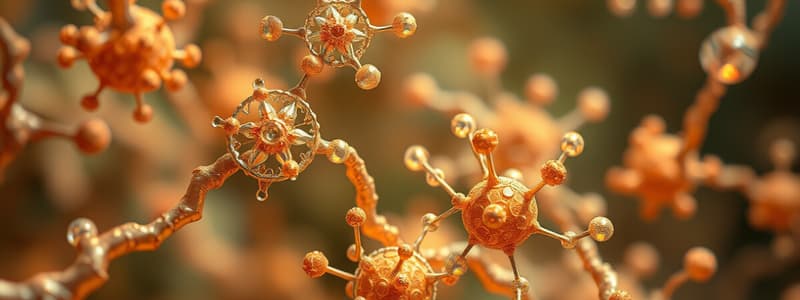Podcast
Questions and Answers
What is the primary focus of biochemistry?
What is the primary focus of biochemistry?
- Physical properties of matter
- Chemical processes within living organisms (correct)
- Environmental interactions of chemicals
- Study of living organisms
What role do enzymes play in biological reactions?
What role do enzymes play in biological reactions?
- Initiate metabolic breakdown processes
- Catalyze reactions by lowering activation energy (correct)
- Increase activation energy
- Serve as energy storage molecules
Which type of biomolecule is primarily responsible for genetic information storage?
Which type of biomolecule is primarily responsible for genetic information storage?
- Carbohydrates
- Lipids
- Nucleic acids (correct)
- Proteins
Which process is represented by the equation 6CO2 + 6H2O → C6H12O6 + 6O2?
Which process is represented by the equation 6CO2 + 6H2O → C6H12O6 + 6O2?
What is the function of carbohydrates in living organisms?
What is the function of carbohydrates in living organisms?
Which statement best describes the relationship between catabolism and anabolism?
Which statement best describes the relationship between catabolism and anabolism?
Which experimental technique is used to separate molecules based on size and charge?
Which experimental technique is used to separate molecules based on size and charge?
What is one application of understanding chemical principles in relation to biology?
What is one application of understanding chemical principles in relation to biology?
Flashcards are hidden until you start studying
Study Notes
Biology and Chemistry Overview
Fundamental Concepts
- Biology: Study of living organisms, their structure, function, growth, evolution, and interactions.
- Chemistry: Study of matter, its properties, composition, and the changes it undergoes during chemical reactions.
Relationship between Biology and Chemistry
- Biochemistry: Branch of science that explores the chemical processes within and related to living organisms.
- Focuses on biomolecules: carbohydrates, proteins, lipids, and nucleic acids.
- Metabolism: All chemical reactions in biological organisms, including:
- Catabolism: Breakdown of molecules to obtain energy.
- Anabolism: Synthesis of complex molecules from simpler ones.
Key Biological Molecules
-
Carbohydrates
- Composed of carbon, hydrogen, and oxygen.
- Functions: energy storage (e.g., starch, glycogen), structural (e.g., cellulose).
-
Proteins
- Made of amino acids linked by peptide bonds.
- Functions: enzymes, structural components, transport (e.g., hemoglobin).
-
Lipids
- Hydrophobic molecules, including fats, oils, and steroids.
- Functions: energy storage, cell membrane structure, signaling.
-
Nucleic Acids
- DNA and RNA, composed of nucleotides.
- Functions: genetic information storage (DNA), protein synthesis (RNA).
Chemical Reactions in Biology
-
Enzymatic Reactions: Catalyzed by enzymes, which lower activation energy and increase reaction rates.
-
Photosynthesis: Conversion of light energy into chemical energy (glucose) by plants.
- Equation: 6CO2 + 6H2O → C6H12O6 + 6O2.
-
Cellular Respiration: Process by which cells convert glucose into energy (ATP).
- Equation: C6H12O6 + 6O2 → 6CO2 + 6H2O + ATP.
Importance of Chemistry in Biology
- Understanding biochemical pathways and molecular structures enhances insights into:
- Genetic engineering and biotechnology.
- Drug design and pharmacology.
- Nutritional science and metabolism.
Experimental Techniques
- Chromatography: Separating mixtures for analysis of compounds.
- Spectroscopy: Analyzing substances based on light absorption/emission properties.
- Electrophoresis: Separating molecules based on size and charge.
Conclusion
- Biology and chemistry are interlinked; understanding chemical principles is essential for exploring biological systems and phenomena.
Fundamental Concepts
- Biology studies living organisms, focusing on their structure, function, growth, evolution, and interactions.
- Chemistry examines matter, its properties, composition, and changes during chemical reactions.
Relationship between Biology and Chemistry
- Biochemistry delves into chemical processes in living organisms, highlighting the role of biomolecules like carbohydrates, proteins, lipids, and nucleic acids.
- Metabolism encompasses all chemical reactions in organisms, divided into:
- Catabolism: the breakdown of molecules for energy.
- Anabolism: the synthesis of complex molecules from simpler components.
Key Biological Molecules
- Carbohydrates: Composed of carbon, hydrogen, and oxygen; serve in energy storage (starch, glycogen) and provide structural support (cellulose).
- Proteins: Constructed from amino acids linked by peptide bonds; function as enzymes, structural components, and transport proteins (e.g., hemoglobin).
- Lipids: Hydrophobic substances, including fats, oils, and steroids; crucial for energy storage, cell membrane structure, and signaling.
- Nucleic Acids: DNA and RNA formed from nucleotides; essential for genetic information storage (DNA) and protein synthesis (RNA).
Chemical Reactions in Biology
- Enzymatic reactions are facilitated by enzymes that lower activation energy, enhancing reaction rates.
- Photosynthesis transforms light energy into chemical energy, producing glucose from carbon dioxide and water, represented by the equation: 6CO2 + 6H2O → C6H12O6 + 6O2.
- Cellular respiration converts glucose into energy (ATP), with the equation: C6H12O6 + 6O2 → 6CO2 + 6H2O + ATP.
Importance of Chemistry in Biology
- Biochemical pathways and molecular structures offer critical understanding for:
- Genetic engineering and biotechnology advancements.
- Drug design and pharmacological studies.
- Nutritional science and metabolic insights.
Experimental Techniques
- Chromatography: A method for separating mixtures to analyze compounds.
- Spectroscopy: Technique for analyzing substances via light absorption/emission properties.
- Electrophoresis: Process for separating molecules based on size and charge.
Conclusion
- Biology and chemistry are interconnected; a solid understanding of chemical principles is crucial for investigating biological systems and their complexities.
Studying That Suits You
Use AI to generate personalized quizzes and flashcards to suit your learning preferences.




